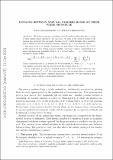Distance between natural numbers based on their prime signature
Abstract
Each natural number is uniquely determined by its prime signature, an infinite dimensional vector indexed by the prime numbers in increasing order. We use this to define a new metric between natural numbers induced by the l∞ norm of the signatures. In this space, we look at the natural analog of the number line and, in particular, study the arithmetic function L∞(N), which tabulates the cumulative sum of distances between consecutive natural numbers up to N in this new metric. Our main result is to identify the positive and finite limit of the sequence L∞(N)/N as the expectation of a certain random variable. The main technical contribution is to show with elementary probability that for K=1, 2 or 3 and ω0,= ..., = ωK ≥ 2 the following asymptotic density holds lim n→ ∞ |{M ≤ n: ||M-j||∞ < ωj for j = 0, ..., K}|/n= π p:prime (1-KΣj=0 1/pωj) This is a generalization of the formula for k-free numbers, i.e. when ω0 = ... = ωK = k. The random variable is derived from the joint distribution when K = 1. As an application, we obtained a modified version of the prime number theorem. our computations up to N = 1012 have also revealed that prime gaps show a considerably richer structure than on the traditional number line. Moreover, we raise additional open problems, which could be of independent interest.
Citation
Kolossváry , I B & Kolossváry , I T 2022 , ' Distance between natural numbers based on their prime signature ' , Journal of Number Theory , vol. 234 , pp. 120-139 . https://doi.org/10.1016/j.jnt.2021.09.010
Publication
Journal of Number Theory
Status
Peer reviewed
ISSN
0022-314XType
Journal article
Description
Funding: ITK was financially supported by a Leverhulme Trust Research Project Grant (RPG-2019-034).Collections
Items in the St Andrews Research Repository are protected by copyright, with all rights reserved, unless otherwise indicated.

